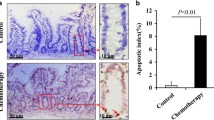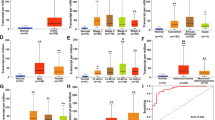Abstract
Purpose
Acute intestinal damage induced by chemotherapeutic agent is often a dose-limiting factor in clinical cancer therapy. The aim of this study was to investigate the effect of chemokine CXCL9 on the intestinal damage after chemotherapy and explore the therapeutic potential of anti-CXCL9 agents.
Methods
In vitro cell proliferation assay was performed with a non-tumorigenic human epithelial cell line MCF10A. Multiple pathway analysis was carried out to explore the pathway that mediated the effect of CXCL9, and the corresponding downstream effector was identified with enzyme-linked immunosorbent assays. Chemotherapy-induced mouse model of intestinal mucositis was prepared by a single injection of the chemotherapeutic agent 5-fluorouracil (5-FU). In vivo expression of cxcl9 and its receptor cxcr3 in intestinal mucosa after chemotherapy was determined by quantitative real-time PCR. Therapeutic treatment with anti-CXCL9 antibodies was investigated to confirm the hypothesis that CXCL9 can contribute to the intestinal epithelium damage induced by chemotherapy.
Results
CXCL9 inhibited the proliferation of MCF10A cells by activating phosphorylation of p70 ribosomal S6 kinase (p70S6K), which further promotes the secretion of transforming growth factor beta (TGF-β) as the downstream effector. A blockade of phospho-p70S6K with inhibitor abolished the effect of CXCL9 on MCF10A cells and reduced the secretion of TGF-β. The expression levels of cxcl9 and cxcr3 were significantly up-regulated in intestinal mucosa after 5-FU injection. Neutralizing elevated CXCL9 with anti-CXCR9 antibodies successfully enhanced reconstitution of intestinal mucosa and improved the survival rate of mice that received high-dose chemotherapy.
Conclusions
CXCL9 inhibits the proliferation of epithelial cells via phosphorylation of p70S6K, resulting in the excretion of TGF-β as downstream mediator. CXCL9/CXCR3 interaction can exacerbate chemotherapeutic agent-induced intestinal damage, and anti-CXCL9 agents are potential novel therapeutic candidates for promoting mucosal restitution.





Similar content being viewed by others
References
Aksoy MO, Yang Y, Ji R, Reddy PJ, Shahabuddin S, Litvin J et al (2006) CXCR3 surface expression in human airway epithelial cells: cell cycle dependence and effect on cell proliferation. Am J Physiol Lung Cell Mol Physiol 290(5):L909–L918
Bierie B, Chung CH, Parker JS, Stover DG, Cheng N, Chytil A et al (2009) Abrogation of TGF-beta signaling enhances chemokine production and correlates with prognosis in human breast cancer. J Clin Invest 119(6):1571–1582
Blijlevens NM, Donnelly JP, De Pauw BE (2000) Mucosal barrier injury: biology, pathology, clinical counterparts and consequences of intensive treatment for haematological malignancy—an overview. Bone Marrow Transpl 25(12):1269–1278
Bonacchi A, Romagnani P, Romanelli RG, Efsen E, Annunziato F, Lasagni L et al (2001) Signal transduction by the chemokine receptor CXCR3: activation of Ras/ERK, Src, and phosphatidylinositol 3-kinase/Akt controls cell migration and proliferation in human vascular pericytes. J Biol Chem 276(13):9945–9954
Cammisotto PG, Bendayan M (2007) Leptin secretion by white adipose tissue and gastric mucosa. Histol Histopathol 22(2):199–210
Coma G, Pena R, Blanco J, Rosell A, Borras FE, Este JA et al (2006) Treatment of monocytes with interleukin (IL)-12 plus IL-18 stimulates survival, differentiation and the production of CXC chemokine ligands (CXCL)8, CXCL9 and CXCL10. Clin Exp Immunol 145(3):535–544
Denicourt C, Dowdy SF (2003) Another twist in the transforming growth factor beta-induced cell cycle arrest chronicle. Proc Natl Acad Sci USA 100(26):15290–15291
Dwinell MB, Lugering N, Eckmann L, Kagnoff MF (2001) Regulated production of interferon-inducible T-cell chemoattractants by human intestinal epithelial cells. Gastroenterology 120(1):49–59
Fahim MA, Kataya H, El-Kharrag R, Amer DA, al-Ramadi B, Karam SM (2011) Ghrelin attenuates gastrointestinal epithelial damage induced by doxorubicin. World J Gastroenterol 17(33):3836–3841
Gorbachev AV, Kobayashi H, Kudo D, Tannenbaum CS, Finke JH, Shu S et al (2007) CXC chemokine ligand 9/monokine induced by IFN-gamma production by tumor cells is critical for T cell-mediated suppression of cutaneous tumors. J Immunol 178(4):2278–2286
Groom JR, Luster AD (2011) CXCR3 ligands: redundant, collaborative and antagonistic functions. Immunol Cell Biol 89(2):207–215
Han X, Wu Z, Di J, Pan Y, Zhang H, Du Y et al (2011) CXCL9 attenuated chemotherapy-induced intestinal mucositis by inhibiting proliferation and reducing apoptosis. Biomed Pharmacother 65(8):547–554
Hertenstein A, Schumacher T, Litzenburger U, Opitz CA, Falk CS, Serafini T et al (2011) Suppression of human CD4+ T cell activation by 3,4-dimethoxycinnamonyl-anthranilic acid (tranilast) is mediated by CXCL9 and CXCL10. Biochem Pharmacol 82(6):632–641
Khaleghpour K, Li Y, Banville D, Yu Z, Shen SH (2004) Involvement of the PI 3-kinase signaling pathway in progression of colon adenocarcinoma. Carcinogenesis 25(2):241–248
Kobayashi H, Novick AC, Toma H, Fairchild RL (2002) Chronic antagonism of Mig inhibits cellular infiltration and promotes survival of class II MHC disparate skin allografts. Transplantation 74(3):387–395
Lu H, Zhu S, Qian L, Xiang D, Zhang W, Nie A et al (2012) Activated expression of the chemokine Mig after chemotherapy contributes to chemotherapy-induced bone marrow suppression and lethal toxicity. Blood 119(21):4868–4877
Nishi T, Iwasaki K, Ohashi N, Tanaka C, Kobayashi D, Nakayama G et al (2013) Phosphorylation of 4E-BP1 predicts sensitivity to everolimus in gastric cancer cells. Cancer Lett 331(2):220–229
Ohta K, Shigeishi H, Taki M, Nishi H, Higashikawa K, Takechi M et al (2008) Regulation of CXCL9/10/11 in oral keratinocytes and fibroblasts. J Dent Res 87(12):1160–1165
Pan J, Burdick MD, Belperio JA, Xue YY, Gerard C, Sharma S et al (2006) CXCR3/CXCR3 ligand biological axis impairs RENCA tumor growth by a mechanism of immunoangiostasis. J Immunol 176(3):1456–1464
Pechkovsky DV, Goldmann T, Ludwig C, Prasse A, Vollmer E, Muller-Quernheim J et al (2005) CCR2 and CXCR3 agonistic chemokines are differently expressed and regulated in human alveolar epithelial cells type II. Respir Res 6:75
Petrai I, Rombouts K, Lasagni L, Annunziato F, Cosmi L, Romanelli RG et al (2008) Activation of p38(MAPK) mediates the angiostatic effect of the chemokine receptor CXCR3-B. Int J Biochem Cell Biol 40(9):1764–1774
Qian L, Zhu S, Shen J, Han X, Gao J, Wu M et al (2012) Expression and purification of recombinant human Mig in Escherichia coli and its comparison with murine Mig. Protein Expr Purif 82(1):205–211
Romagnani P, Annunziato F, Lasagni L, Lazzeri E, Beltrame C, Francalanci M et al (2001) Cell cycle-dependent expression of CXC chemokine receptor 3 by endothelial cells mediates angiostatic activity. J Clin Invest 107(1):53–63
Ryu JM, Lee MY, Yun SP, Han HJ (2010) High glucose regulates cyclin D1/E of human mesenchymal stem cells through TGF-beta1 expression via Ca2+/PKC/MAPKs and PI3 K/Akt/mTOR signal pathways. J Cell Physiol 224(1):59–70
Sabatini DM (2006) mTOR and cancer: insights into a complex relationship. Nat Rev Cancer 6(9):729–734
Saltis J (1996) TGF-beta: receptors and cell cycle arrest. Mol Cell Endocrinol 116(2):227–232
Schiffrin EJ, Blum S (2002) Interactions between the microbiota and the intestinal mucosa. Eur J Clin Nutr 56(Suppl 3):S60–S64
Schwarz JB, Langwieser N, Langwieser NN, Bek MJ, Seidl S, Eckstein HH et al (2009) Novel role of the CXC chemokine receptor 3 in inflammatory response to arterial injury: involvement of mTORC1. Circ Res 104(2):189–200
Shahabuddin S, Ji R, Wang P, Brailoiu E, Dun N, Yang Y et al (2006) CXCR3 chemokine receptor-induced chemotaxis in human airway epithelial cells: role of p38 MAPK and PI3 K signaling pathways. J Cell Physiol 291(1):C34–C39
Shin S, Wolgamott L, Yu Y, Blenis J, Yoon SO (2011) Glycogen synthase kinase (GSK)-3 promotes p70 ribosomal protein S6 kinase (p70S6K) activity and cell proliferation. Proc Natl Acad Sci USA 108(47):E1204–E1213
Vanguri P, Farber JM (1990) Identification of CRG-2. An interferon-inducible mRNA predicted to encode a murine monokine. J Biol Chem 265(25):15049–15057
Willox I, Mirkina I, Westwick J, Ward SG (2010) Evidence for PI3 K-dependent CXCR3 agonist-induced degranulation of human cord blood-derived mast cells. Mol Immunol 47(14):2367–2377
Xiao YQ, Freire-de-Lima CG, Schiemann WP, Bratton DL, Vandivier RW, Henson PM (2008) Transcriptional and translational regulation of TGF-beta production in response to apoptotic cells. J Immunol 181(5):3575–3585
Zhang R, Tian L, Chen LJ, Xiao F, Hou JM, Zhao X et al (2006) Combination of MIG (CXCL9) chemokine gene therapy with low-dose cisplatin improves therapeutic efficacy against murine carcinoma. Gene Ther 13(17):1263–1271
Acknowledgments
This work was supported by the National Natural Science Foundation of China (grant number 81273576, 30801419, 30901873) and the German Academic Exchange Service and China Scholarship Council (Grant number A/09/90104). We would also like to thank Dr. Baier and Ms. Krohl at the Robert Koch Institute in Berlin, Germany, for their kind help in the technology of immunohistochemistry.
Conflict of interest
We declare no competing interests.
Author information
Authors and Affiliations
Corresponding authors
Electronic supplementary material
Below is the link to the electronic supplementary material.
Rights and permissions
About this article
Cite this article
Lu, H., Liu, H., Wang, J. et al. The chemokine CXCL9 exacerbates chemotherapy-induced acute intestinal damage through inhibition of mucosal restitution. J Cancer Res Clin Oncol 141, 983–992 (2015). https://doi.org/10.1007/s00432-014-1869-y
Received:
Accepted:
Published:
Issue Date:
DOI: https://doi.org/10.1007/s00432-014-1869-y




